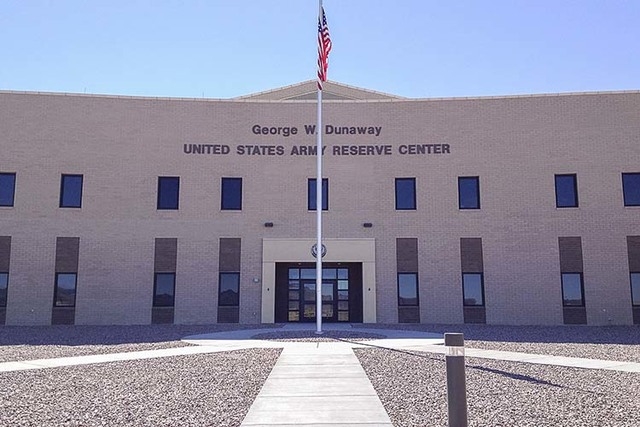New Vegas Reserve Center has arsenic problem

They can flush the toilets, but they can’t drink the water. At least for now.
Ever since citizen-soldiers moved into the George W. Dunaway Army Reserve Center in Sloan last year, they have been using the spacious building for training and weekend drills without full access to water from a 900-foot-deep well that supplies the facility.
The problem: Arsenic levels are slightly higher than the Environmental Protection Agency allows, and Nevada’s Safe Drinking Water Bureau won’t let the Army Reserve use it for drinking or taking showers until the treatment system meets improvements that were recommended after a May inspection.
“The contractor apparently didn’t follow the requirements the state would have set down,” Maj. Gen. Nick Tooliatos said Friday. “We expect the complete cost to repair the filter that was installed at the outset of the building ranges right at about $200,000.”
He didn’t know the contractor’s name because construction was managed by another branch of the military, the Army Corps of Engineers, before ownership of the facility was transferred to the Army Reserve in 2013.
Previously, the EPA standard for arsenic in drinking water was 50 parts per billion. But after studies showed the colorless, odorless, naturally occurring element might have an increased risk of causing cancer and skin problems for people who drink it over many years, a new standard of 10 parts per billion was adopted in 2002, with a decision that public water systems must comply with the standard in early 2006.
The Army Reserve Center’s well was drilled in 2011.
Jennifer Carr, chief of the Bureau of Safe Drinking Water for the Nevada Division of Environmental Protection, said the level of arsenic coming from the Army Reserve’s well in Sloan was 13 parts per billion, 3 parts per billion higher than the EPA’s standard.
When upgrades are completed to meet the state’s expectations for permitting the system, she expects the Dunaway Army Reserve Center will be allowed full use of treated well water “somewhere on the scale of the next few months.”
“The ball is in their court to fix the items identified on May 29,” Carr said, noting that the inspection turned up “various technical and engineering issues” and the need for a well-discharge flow meter.
“We have another, completing engineering installation approval process, and then we will be able to issue them a permit to operate. I had expected we would be beyond that by now,” Carr said.
She said the treatment system uses granular absorption technology.
In other words, well water is passed through grains in a vessel that attract arsenic. When the grains become saturated with arsenic, they are retrieved and replaced with fresh ones. The used ones are either recycled or disposed of in a licensed landfill.
Tooliatos, commander of the 63rd Regional Support Command in Mountain View, Calif., which is responsible for the center 19 miles south of Las Vegas off Interstate 15, said the building was constructed in 2012 under the first phase of the project for $33.9 million.
More structures will be built under the $21 million second phase. When finished, the combined facilities will serve nine Army Reserve units.
The new center is needed for Southern Nevada because weekend training and other missions for Army reservists are spread among the aging Taylor Hall in Las Vegas, the joint Armed Forces Reserve Center at Nellis Air Force Base and a transportation facility that was converted from a former car dealership in the northwest Las Vegas Valley.
Tooliatos said he hopes upgrades will bring the system into compliance so that it can be permitted before an official opening and memorialization ceremony is held next year.
“From my perspective, anytime that we can provide facilities that improve a commander’s ability to fight, win and survive our nation’s wars we are providing a required resource,” he said.
Then, when the soldiers become candidates for mobilization “they are prepared as they can be,” Tooliatos said.
He noted that the Army Reserve is “an integral part of the active component” that offers a variety of capabilities including combat support and force sustainment. “We will continue to play an operational role going forward” even as the war in Afghanistan winds down, he said.
On a visit to the center Aug. 15, Lt. Col. Debra Cisney, commander of the 63rd Brigade Support Battalion, said that while the upgrades have been in progress, soldiers at the center have been drinking bottled water, and the restrooms have been supplied with sanitary hand gels.
Tooliatos said the cost for bottled water hasn’t been very much, only about $2,000 since December.
Maj. Jerry A. Brown, executive officer at the center, said the opening and memorialization event for the 28,000-square-foot facility is on track for April 5.
The center is named for George W. Dunaway, the nation’s second sergeant major of the Army, who restored integrity to the highest enlisted post after a scandal in Vietnam. He died in 2008 in Las Vegas, where he had lived for 22 years in retirement.
A highly decorated soldier and recipient of the Silver Star, Bronze Star and Purple Heart medals, he was called into active duty for the National Guard in World War II, served in a noncombat role during the Korean War, and trained Special Forces units and served with them during the Vietnam War.
In Las Vegas, Dunaway became a fixture at Army and Special Forces Association functions and was routinely on hand to bid farewell to troops departing for the wars in Iraq and Afghanistan and was among the first to greet them when they returned.
Contact Keith Rogers at krogers@reviewjournal.com or 702-383-0308. Follow @KeithRogers2 on Twitter.